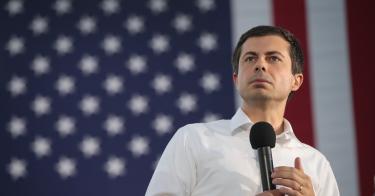On Dec. 15, Joe Biden announced former South Bend Mayor Pete Buttigieg as his nominee for secretary of transportation. For an administration led by a man nicknamed “Amtrak Joe”—due to his frequent use of a socialized rail line—infrastructure will be a pivotal issue.
Acknowledging the nomination, Buttigieg tweeted: “This is a moment of tremendous opportunity—to create jobs, meet the climate challenge, and enhance equity for all.”
This gets the issue backward and demonstrates the misguided way he and the Biden administration are planning to approach infrastructure.
Infrastructure exists to efficiently transport people and goods. While aspects such as environmental effects deserve attention, federal infrastructure policy is not the proper vehicle for addressing unemployment, poverty reduction or global emission levels.
Turning secondary considerations into the top priorities makes it more likely that the administration will try to fund projects with minimal economic value for the sake of promoting a social and environmental agenda.
For decades, the left has sought to entice or force Americans into using mass transit and intercity rail rather than automobiles. In some cases, this involves massive subsidies for transit, such as the hundreds of billions of dollars that have been diverted from the gas tax-fueled Highway Trust Fund into transit agencies.
In other cases, this involves deliberate choices to sabotage drivers, such as local “road diets” and under-funding road maintenance.
Even after all that, most Americans still rely on cars to get where they need to go. There’s a good reason for this: America has a much lower population density than places with higher rates of transit use such as Japan and Western Europe.
Millions of families prefer to live in suburbs rather than urban cores. The increasing use of telework will allow millions more to choose to live in lower-cost communities, and there is plenty of space for those communities to expand. No amount of transit promotion will change this reality, and it is foolish to pretend otherwise.
On the economic front, infrastructure projects are worthwhile based on how much value they deliver when in use, not based on how much labor they take to complete. After all, if increasing work hours was the main goal, we would have construction workers dig with spoons rather than backhoes.
Infrastructure projects proved to be an ineffective way to create jobs during the Obama administration. The 2009 stimulus bill was famously promoted as funding “shovel ready” projects, yet these projects often took years to start due to excessive environmental review rules.
Follow-up analysis by The Heritage Foundation showed that, rather than creating new jobs in construction, the stimulus funding mostly served to move skilled workers from private projects to government ones. There is no reason to expect different results just a decade later.
Further, with the unemployment rate currently lower than it was from 2009 through 2012, a federally funded jobs program makes even less sense today.
On climate, Mayor Buttigieg could use carrots and sticks to force more electric vehicles into the market. The Department of Transportation is likely to ratchet up fuel economy mandates, where automakers will receive credits for electric vehicles and hybrids.
Mandates will drive up the sticker price by thousands of dollars and price new car buyers out of the market. There will be calls for bigger budgets to ramp up spending on batteries and charging stations, and to extend subsidies for electric vehicle purchases—all of which would lead to a negligible climate impact.
Rather than seeking to boost federal spending for the sake of unrealistic goals, Buttigieg can improve the nation’s infrastructure by reducing the burden of regulation.
While many key rules can be addressed only through legislation, the Biden administration should build on reforms made under the Trump administration.
Doing so would yield economic and environmental benefits as companies build infrastructure in a timely fashion that is more resilient, efficient and relieves congestion.
Unfortunately, it appears that the Biden administration will move in the opposite direction, entrenching and expanding rules that increase the cost and approval time for infrastructure projects.
Federal mandates relating to pay scales and domestic-only material sourcing drive up the cost of projects without improving quality, meaning we get less infrastructure for each taxpayer dollar.
Pete Buttigieg is right to say that he will have a tremendous opportunity if he is confirmed as secretary of transportation.
However, if he sticks to policies and goals that have no hope of improving the nation’s infrastructure, he will squander that opportunity.
This piece originally appeared in The Detroit News



